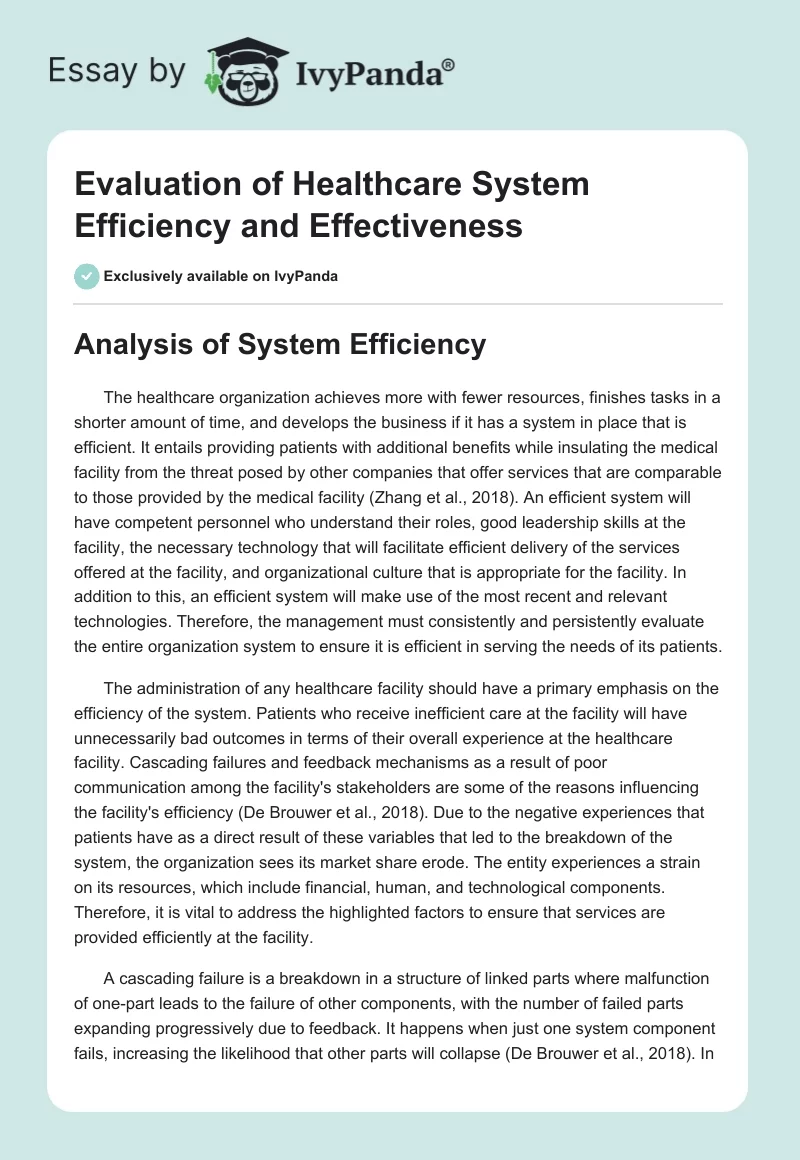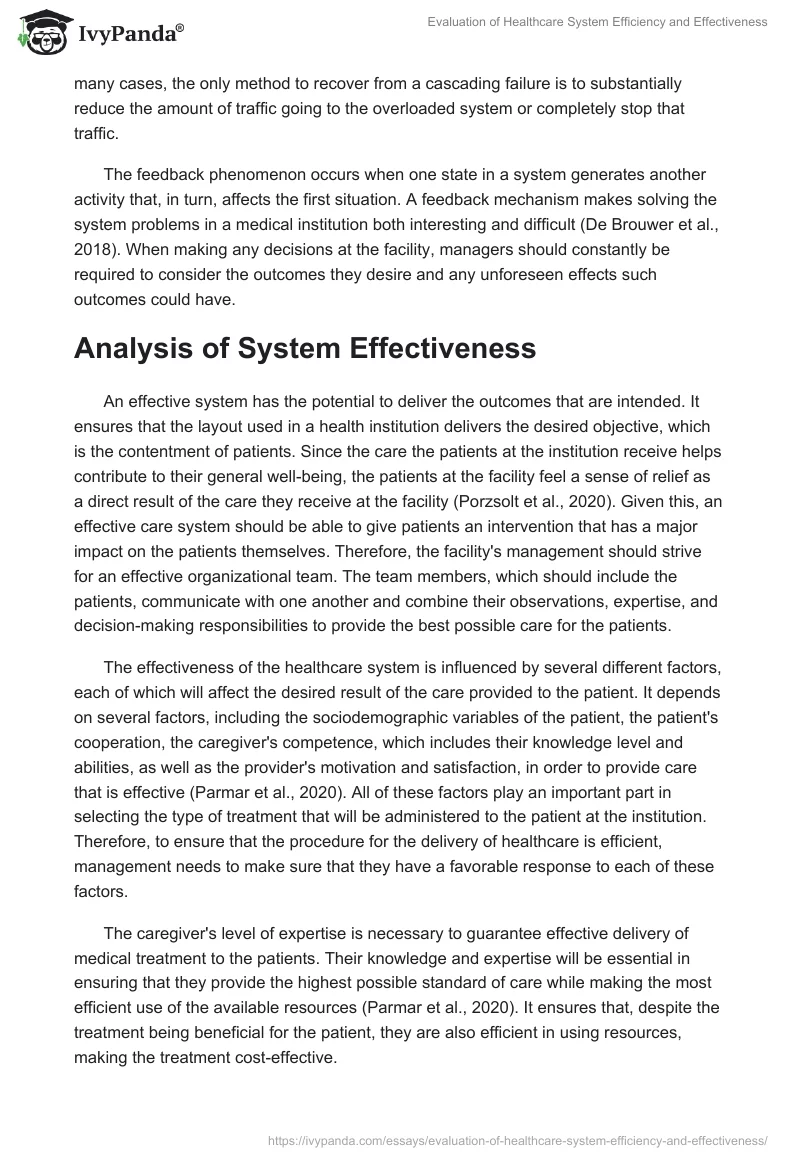Analysis of System Efficiency
The healthcare organization achieves more with fewer resources, finishes tasks in a shorter amount of time, and develops the business if it has a system in place that is efficient. It entails providing patients with additional benefits while insulating the medical facility from the threat posed by other companies that offer services that are comparable to those provided by the medical facility (Zhang et al., 2018). An efficient system will have competent personnel who understand their roles, good leadership skills at the facility, the necessary technology that will facilitate efficient delivery of the services offered at the facility, and organizational culture that is appropriate for the facility. In addition to this, an efficient system will make use of the most recent and relevant technologies. Therefore, the management must consistently and persistently evaluate the entire organization system to ensure it is efficient in serving the needs of its patients.
The administration of any healthcare facility should have a primary emphasis on the efficiency of the system. Patients who receive inefficient care at the facility will have unnecessarily bad outcomes in terms of their overall experience at the healthcare facility. Cascading failures and feedback mechanisms as a result of poor communication among the facility’s stakeholders are some of the reasons influencing the facility’s efficiency (De Brouwer et al., 2018). Due to the negative experiences that patients have as a direct result of these variables that led to the breakdown of the system, the organization sees its market share erode. The entity experiences a strain on its resources, which include financial, human, and technological components. Therefore, it is vital to address the highlighted factors to ensure that services are provided efficiently at the facility.
A cascading failure is a breakdown in a structure of linked parts where malfunction of one-part leads to the failure of other components, with the number of failed parts expanding progressively due to feedback. It happens when just one system component fails, increasing the likelihood that other parts will collapse (De Brouwer et al., 2018). In many cases, the only method to recover from a cascading failure is to substantially reduce the amount of traffic going to the overloaded system or completely stop that traffic.
The feedback phenomenon occurs when one state in a system generates another activity that, in turn, affects the first situation. A feedback mechanism makes solving the system problems in a medical institution both interesting and difficult (De Brouwer et al., 2018). When making any decisions at the facility, managers should constantly be required to consider the outcomes they desire and any unforeseen effects such outcomes could have.
Analysis of System Effectiveness
An effective system has the potential to deliver the outcomes that are intended. It ensures that the layout used in a health institution delivers the desired objective, which is the contentment of patients. Since the care the patients at the institution receive helps contribute to their general well-being, the patients at the facility feel a sense of relief as a direct result of the care they receive at the facility (Porzsolt et al., 2020). Given this, an effective care system should be able to give patients an intervention that has a major impact on the patients themselves. Therefore, the facility’s management should strive for an effective organizational team. The team members, which should include the patients, communicate with one another and combine their observations, expertise, and decision-making responsibilities to provide the best possible care for the patients.
The effectiveness of the healthcare system is influenced by several different factors, each of which will affect the desired result of the care provided to the patient. It depends on several factors, including the sociodemographic variables of the patient, the patient’s cooperation, the caregiver’s competence, which includes their knowledge level and abilities, as well as the provider’s motivation and satisfaction, in order to provide care that is effective (Parmar et al., 2020). All of these factors play an important part in selecting the type of treatment that will be administered to the patient at the institution. Therefore, to ensure that the procedure for the delivery of healthcare is efficient, management needs to make sure that they have a favorable response to each of these factors.
The caregiver’s level of expertise is necessary to guarantee effective delivery of medical treatment to the patients. Their knowledge and expertise will be essential in ensuring that they provide the highest possible standard of care while making the most efficient use of the available resources (Parmar et al., 2020). It ensures that, despite the treatment being beneficial for the patient, they are also efficient in using resources, making the treatment cost-effective.
The patient should cooperate with the caregiver to ensure that the caregiver provides the appropriate information to the professionals. It is, therefore, possible for medical professionals to arrive at an accurate diagnosis of the patient’s condition (Li et al., 2018). Due to this, the caregivers can provide the patient with the kind of care that is most likely to result in a speedy recovery. Therefore, it is the responsibility of management to ensure that they enhance patient awareness to guarantee that patients receive effective treatment at the healthcare institution.
References
De Brouwer, M., Ongenae, F., Bonte, P., & De Turck, F. (2018). Towards a cascading reasoning framework to support responsive ambient-intelligent healthcare interventions. Sensors, 18(10), 3514. Web.
Li, Y., Wang, H., Li, Y., & Li, L. (2018). Patient assignment scheduling in a cloud healthcare system based on Petri net and greedy-based heuristic. Enterprise Information Systems, 13(4), 515–533. Web.
Parmar, J., Anderson, S., Duggleby, W., Holroyd‐Leduc, J., Pollard, C., & Brémault‐Phillips, S. (2020). Developing person-centered care competencies for the healthcare workforce to support family caregivers: Caregiver centred care. Health & Social Care in the Community, 29(5), 1327–1338. Web.
Porzsolt, F., Wiedemann, F., Phlippen, M., Weiss, C., Weiss, M., Schmaling, K., & Kaplan, R. M. (2020). The terminology conflict on efficacy and effectiveness in healthcare. Journal of Comparative Effectiveness Research, 9(17), 1171–1178. Web.
Zhang, R., Ma, J., & Ji, H. (2018). Evaluation of healthcare system efficiency based on DEA algorithm. Journal of Discrete Mathematical Sciences and Cryptography, 21(4), 937–946. Web.


